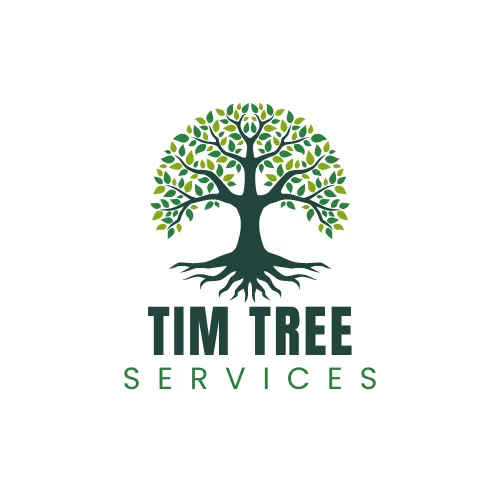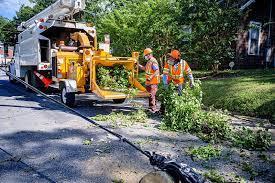




Safely Navigating the Art and Science of Arboriculture

Tree cutting is both an art and a science, requiring precision, skill, and a thorough understanding of tree biology and mechanics. Whether you're pruning branches for maintenance or felling a tree for removal, employing proper techniques and prioritizing safety is paramount to a successful and incident-free operation. Let's explore some essential tree cutting techniques and safety practices that every arborist should master:
Assessing the Tree and Surroundings: Before embarking on any tree cutting operation, it's crucial to assess the tree's health, structure, and surroundings. Identify any potential hazards, such as dead or diseased limbs, overhead power lines, nearby structures, or uneven terrain, that may impact the safety and efficiency of the job. Plan your approach accordingly and establish clear escape routes in case of emergencies. Selecting the Right Tools and Equipment: Choosing the appropriate tools and equipment for the job is essential for achieving optimal results and ensuring safety. This may include chainsaws, hand saws, pruning shears, ropes, harnesses, and personal protective equipment (PPE) such as helmets, gloves, and safety glasses. Ensure that all equipment is in good working condition and properly maintained to minimize the risk of accidents or malfunctions. Practicing Proper Cutting Techniques: Different tree cutting techniques are employed depending on the nature of the task at hand. For pruning branches, use the three-cut method to prevent bark tearing and promote wound healing. When felling a tree, employ directional felling techniques to control the tree's fall and minimize damage to surrounding structures. Back cuts, plunge cuts, and notch cuts are some of the common techniques used to guide the tree's descent safely and accurately. Maintaining Safe Working Conditions: Safety should always be the top priority when performing tree cutting operations. Ensure that all personnel are trained in safe work practices and equipped with the necessary PPE. Clear the work area of debris, trip hazards, and bystanders, and establish a safety perimeter to prevent unauthorized entry. Communicate with your team and establish clear signals and protocols for coordinating movements and actions during the operation. Mitigating Risk and Hazardous Situations: Throughout the tree cutting process, remain vigilant and proactive in identifying and addressing potential hazards and risks. Monitor for signs of instability or unexpected movement in the tree, such as cracking sounds or shifting branches, and be prepared to adjust your approach accordingly. Stay alert to changing weather conditions and environmental factors that may impact the safety and feasibility of the operation. Seeking Professional Assistance When Necessary: While many tree cutting tasks can be safely performed by experienced arborists, some situations may require specialized knowledge, equipment, and expertise. For complex or high-risk operations, such as removing trees near power lines or in confined spaces, it's advisable to seek the assistance of certified arborists or tree care professionals who have the training and equipment to handle the job safely and effectively.
In conclusion, mastering tree cutting techniques and prioritizing safety are essential for arborists and tree care professionals. By assessing the tree and surroundings, selecting the right tools and equipment, practicing proper cutting techniques, maintaining safe working conditions, mitigating risks, and seeking professional assistance when necessary, arborists can ensure the success and safety of tree cutting operations. With careful planning, skillful execution, and a commitment to safety, arborists can navigate the challenges of tree cutting with confidence and expertise.
Other Articles

Tree Service Equipment and Tools
Behind every successful tree service operation lies a suite of specialized equipment and tools designed to tackle a variety of tasks with precision and efficiency. From pruning and trimming to removal and stump grinding, having the right tools for the job is essential for ensuring the safety of both arborists and the surrounding environment. Let's explore some of the essential equipment and tools used in the tree care industry

Eco-Friendly Tree Service Practices
As stewards of the environment, tree care professionals have a unique responsibility to ensure that their practices promote the health and vitality of trees while minimizing harm to the surrounding ecosystem. Embracing eco-friendly practices not only reduces environmental impact but also contributes to the long-term sustainability of our urban and natural landscapes. Here are some key strategies for incorporating eco-friendly practices into tree care

Tree Service Business and Marketing
In today's competitive landscape, running a successful tree service business requires more than just technical expertise – it demands effective marketing strategies to attract and retain customers. Whether you're a seasoned arborist or just starting out in the industry, implementing smart marketing tactics can help you stand out from the competition and grow your business. Here are some key strategies to consider

Other articles
Come discover a whole new world of trees and how best to manage them.
Testimonials
"I recently hired Tim's Tree Services to take care of some overgrown trees in my backyard, and I couldn't be more pleased with the results. From the initial consultation to the final cleanup, their team displayed professionalism, expertise, and a genuine commitment to excellence. They carefully assessed the situation, provided clear recommendations, and executed the job with precision and care. Not only did they transform my backyard into a safer and more beautiful space, but they also went above and beyond to ensure that the surrounding environment was left undisturbed. I highly recommend Tim's Tree Services to anyone in need of top-notch tree services. Thank you for a job well done!"
"I cannot praise Tim's Tree Services enough for their exceptional tree service! From the initial consultation to the final cleanup, every step of the process was handled with professionalism and expertise. Their team not only expertly pruned the trees on my property but also provided valuable advice on how to maintain their health and beauty in the long term. The care and precision they demonstrated were truly impressive, and the results speak for themselves – my trees look healthier and more vibrant than ever before. I highly recommend them to anyone in need of top-notch tree care services. Thank you for a job well done!"
Safely Navigating the Art and Science of Arboriculture

Tree cutting is both an art and a science, requiring precision, skill, and a thorough understanding of tree biology and mechanics. Whether you're pruning branches for maintenance or felling a tree for removal, employing proper techniques and prioritizing safety is paramount to a successful and incident-free operation. Let's explore some essential tree cutting techniques and safety practices that every arborist should master:
Assessing the Tree and Surroundings: Before embarking on any tree cutting operation, it's crucial to assess the tree's health, structure, and surroundings. Identify any potential hazards, such as dead or diseased limbs, overhead power lines, nearby structures, or uneven terrain, that may impact the safety and efficiency of the job. Plan your approach accordingly and establish clear escape routes in case of emergencies. Selecting the Right Tools and Equipment: Choosing the appropriate tools and equipment for the job is essential for achieving optimal results and ensuring safety. This may include chainsaws, hand saws, pruning shears, ropes, harnesses, and personal protective equipment (PPE) such as helmets, gloves, and safety glasses. Ensure that all equipment is in good working condition and properly maintained to minimize the risk of accidents or malfunctions. Practicing Proper Cutting Techniques: Different tree cutting techniques are employed depending on the nature of the task at hand. For pruning branches, use the three-cut method to prevent bark tearing and promote wound healing. When felling a tree, employ directional felling techniques to control the tree's fall and minimize damage to surrounding structures. Back cuts, plunge cuts, and notch cuts are some of the common techniques used to guide the tree's descent safely and accurately. Maintaining Safe Working Conditions: Safety should always be the top priority when performing tree cutting operations. Ensure that all personnel are trained in safe work practices and equipped with the necessary PPE. Clear the work area of debris, trip hazards, and bystanders, and establish a safety perimeter to prevent unauthorized entry. Communicate with your team and establish clear signals and protocols for coordinating movements and actions during the operation. Mitigating Risk and Hazardous Situations: Throughout the tree cutting process, remain vigilant and proactive in identifying and addressing potential hazards and risks. Monitor for signs of instability or unexpected movement in the tree, such as cracking sounds or shifting branches, and be prepared to adjust your approach accordingly. Stay alert to changing weather conditions and environmental factors that may impact the safety and feasibility of the operation. Seeking Professional Assistance When Necessary: While many tree cutting tasks can be safely performed by experienced arborists, some situations may require specialized knowledge, equipment, and expertise. For complex or high-risk operations, such as removing trees near power lines or in confined spaces, it's advisable to seek the assistance of certified arborists or tree care professionals who have the training and equipment to handle the job safely and effectively.
In conclusion, mastering tree cutting techniques and prioritizing safety are essential for arborists and tree care professionals. By assessing the tree and surroundings, selecting the right tools and equipment, practicing proper cutting techniques, maintaining safe working conditions, mitigating risks, and seeking professional assistance when necessary, arborists can ensure the success and safety of tree cutting operations. With careful planning, skillful execution, and a commitment to safety, arborists can navigate the challenges of tree cutting with confidence and expertise.
Other Articles

Tree Service Equipment and Tools
Behind every successful tree service operation lies a suite of specialized equipment and tools designed to tackle a variety of tasks with precision and efficiency. From pruning and trimming to removal and stump grinding, having the right tools for the job is essential for ensuring the safety of both arborists and the surrounding environment. Let's explore some of the essential equipment and tools used in the tree care industry

Eco-Friendly Tree Service Practices
As stewards of the environment, tree care professionals have a unique responsibility to ensure that their practices promote the health and vitality of trees while minimizing harm to the surrounding ecosystem. Embracing eco-friendly practices not only reduces environmental impact but also contributes to the long-term sustainability of our urban and natural landscapes. Here are some key strategies for incorporating eco-friendly practices into tree care

Tree Service Business and Marketing
In today's competitive landscape, running a successful tree service business requires more than just technical expertise – it demands effective marketing strategies to attract and retain customers. Whether you're a seasoned arborist or just starting out in the industry, implementing smart marketing tactics can help you stand out from the competition and grow your business. Here are some key strategies to consider

Other articles
Come discover a whole new world of trees and how best to manage them.
Testimonials
"I recently hired Tim's Tree Services to take care of some overgrown trees in my backyard, and I couldn't be more pleased with the results. From the initial consultation to the final cleanup, their team displayed professionalism, expertise, and a genuine commitment to excellence. They carefully assessed the situation, provided clear recommendations, and executed the job with precision and care. Not only did they transform my backyard into a safer and more beautiful space, but they also went above and beyond to ensure that the surrounding environment was left undisturbed. I highly recommend Tim's Tree Services to anyone in need of top-notch tree services. Thank you for a job well done!"
"I cannot praise Tim's Tree Services enough for their exceptional tree service! From the initial consultation to the final cleanup, every step of the process was handled with professionalism and expertise. Their team not only expertly pruned the trees on my property but also provided valuable advice on how to maintain their health and beauty in the long term. The care and precision they demonstrated were truly impressive, and the results speak for themselves – my trees look healthier and more vibrant than ever before. I highly recommend them to anyone in need of top-notch tree care services. Thank you for a job well done!"
Contact Us
Service Hours
Social Media
07401097996
Monday - Friday: 9:00 AM - 5:00 PM
Saturday: 10:00 AM - 2:00 PM
Sunday: Closed



Copyright Tim Tree Services 2024

Powered By: Randleads